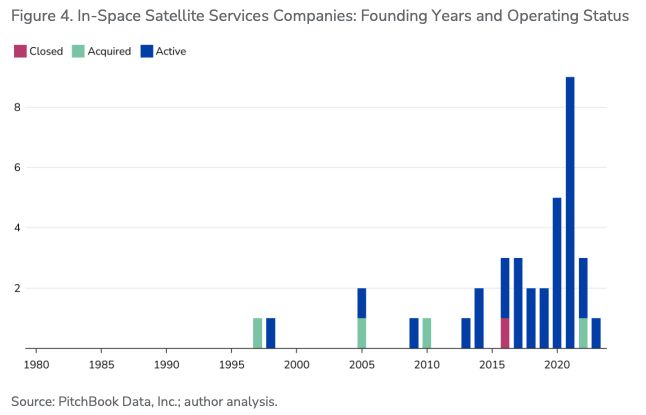
UPenn Alum

They’re building the tech that could define the next decade of space power.
Ignore them, and the U.S. risks ceding ground in the most strategic domain of the century.
They’re building the tech that could define the next decade of space power.
Ignore them, and the U.S. risks ceding ground in the most strategic domain of the century.
Countries that integrate commercial SSA, servicing, and lunar logistics early will shape how those capabilities are used, regulated, and secured.
This is not just about business, it’s about space norms and power projection.
Countries that integrate commercial SSA, servicing, and lunar logistics early will shape how those capabilities are used, regulated, and secured.
This is not just about business, it’s about space norms and power projection.
✅ Use public-private models like CLPS and SBIR
✅ Create pathfinder acquisitions for high-risk tech
✅ Update export rules to better align with allies
✅ Leverage these firms in multilateral norms-setting
✅ Use public-private models like CLPS and SBIR
✅ Create pathfinder acquisitions for high-risk tech
✅ Update export rules to better align with allies
✅ Leverage these firms in multilateral norms-setting
🚫 Export controls restrict dual-use tech transfer
🚫 Public sector crowd-out (e.g. GPS) limits commercial incentives
🚫 Unclear procurement pathways for advanced tech
🚫 High capital costs and unclear ROI
🚫 Export controls restrict dual-use tech transfer
🚫 Public sector crowd-out (e.g. GPS) limits commercial incentives
🚫 Unclear procurement pathways for advanced tech
🚫 High capital costs and unclear ROI
📈 A surge in company formation around 2021
📍 Many firms clustered around orbital servicing and exploration

📈 A surge in company formation around 2021
📍 Many firms clustered around orbital servicing and exploration
First creating automated processes that can work unattended in the space environment and safely returning the products to Earth.
First creating automated processes that can work unattended in the space environment and safely returning the products to Earth.



In-space satellite services encompass space-based SSA; debris remediation; satellite life extension; servicing, repair, and refueling; and in-space (postlaunch) transport of satellites.
In-space satellite services encompass space-based SSA; debris remediation; satellite life extension; servicing, repair, and refueling; and in-space (postlaunch) transport of satellites.

For example, technology spin-offs from exploration provide second-order benefits. Early U.S. dominance in semiconductor manufacturing was driven by the space program
For example, technology spin-offs from exploration provide second-order benefits. Early U.S. dominance in semiconductor manufacturing was driven by the space program
Adding the burden of contested space, where space assets may be targeted by adversaries, only raises the importance of the tracking mission of SSA but again, less than 1 percent work in this area.
Adding the burden of contested space, where space assets may be targeted by adversaries, only raises the importance of the tracking mission of SSA but again, less than 1 percent work in this area.
Startups are now working on expanding LEO PNT capabilities and jam-resistant alternatives.
Still, fewer than 1 percent of all space companies in our dataset are pursuing PNT missions.
Startups are now working on expanding LEO PNT capabilities and jam-resistant alternatives.
Still, fewer than 1 percent of all space companies in our dataset are pursuing PNT missions.
But without clearer demand signals, through procurement or policy, many of these firms could stall before they scale.

But without clearer demand signals, through procurement or policy, many of these firms could stall before they scale.
Many are small firms working on speculative-but-possible tech, sometimes with little government support.
That’s what makes them risky, but strategically essential.
Many are small firms working on speculative-but-possible tech, sometimes with little government support.
That’s what makes them risky, but strategically essential.
@csetgeorgetown.bsky.social report, we identify 91 U.S. companies developing advanced space technologies in five areas of innovation: PNT, ground-based SSA, exploration, and in-space satellite services and manufacturing.

@csetgeorgetown.bsky.social report, we identify 91 U.S. companies developing advanced space technologies in five areas of innovation: PNT, ground-based SSA, exploration, and in-space satellite services and manufacturing.
Read the full piece here:
time.com/7277034/us-a...

Read the full piece here:
time.com/7277034/us-a...
• Coordinating strategy and operations
• Protecting critical infrastructure from hostile actions
• Promoting deterrence and responsible behavior in orbit
• Coordinating strategy and operations
• Protecting critical infrastructure from hostile actions
• Promoting deterrence and responsible behavior in orbit

